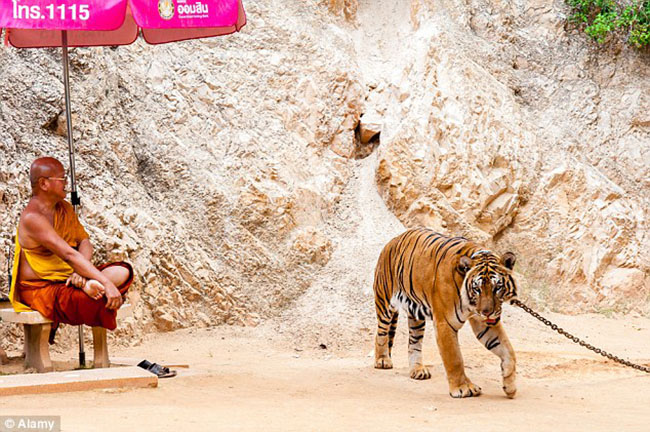The latest reports from Thailand regarding alleged wildlife trade nexus of the infamous Tiger temple have sent shock waves across the world. The infamous tiger temple in the Sai Yok district of the Kanchanaburi province of western Thailand was founded in 1994. Loved and respected globally as a forest temple as well as a sanctuary for wild animals including tigers received iconic status among tourists, conservationists and animal lovers visiting Thailand over past two decades. Happy tourists embracing tigers or feeding them and facing cameras earned rich dividends for the temple. The temple administration earned millions of dollars through admission fees and donations that increased every year with the rapid tourism boom in SE Asia and Thailand. Although often charged with secret trade in tiger body parts and maltreatment of animals; the horrific activities of the temple authorities have been exposed only recently. The Thai authorities have removed 137 adult tigers and other wildlife from the temple campus and closed the facility permanently. Over 40 dead tiger cubs stored in the freezer, tiger pelts, staffed animals and labelled tiger body parts have been confiscated from the temple campus directly showing its involvement in illegal breeding, tiger body part trade and illegal trafficking of wildlife particularly tigers.
Wildlife enthusiasts across the planet are in a state of shock with latest findings, allegations and proofs of illegal wildlife trade, maltreatment and exploitations of wild animals for commercial benefits, misguiding the government, public and investigative agencies for several years and practise of illegal breeding without approval from local and international authorities. The incident is most probably the largest case ever reported from the perspective of illegal retention, breeding, trade and trafficking of wild tigers in the entire world. The Thai authorities must be commended for their sincere efforts in unfolding this saga and for investigating the case in search of the truth. The most important factor that has been worrisome is whether all the tigers in the temple premise are Bengal tigers or Indochinese tigers or Bengal X Indochinese hybrids? Thailand along with Myanmar is the last remaining wild habitats for the rear Indochinese sub species of tigers. If a section of the tigers from the temple is found after thorough genetic tests to be pure bred Indochinese tigers, they should be separated and treated as a viable breeding population under proper supervision for captive breeding and relocation to suitable habitats within Thailand.
If the tigers as reported in the media are all pure bred Bengal tigers; then Thailand after the Indian subcontinent (Bangladesh, Bhutan, India and Nepal) will be the second largest breeding habitat of this particular subspecies. But the important question to ask is whether Thailand has the infrastructure to house, maintain and conduct captive breeding of such a large population of Bengal tigers. Under these circumstances, it will be better to return some of the tigers to the Indian subcontinent nations to continue their breeding programs that have achieved appreciable success in the past decade. Additionally few could be donated to international zoos across the world that has distinguished success in the captive breeding of Bengal tigers. This could boost and actively support the breeding initiatives for endangered Bengal tigers around the globe. However, since these illegal breeding activities in the Thai temple have been conducted without any proper guidelines and much needed technical supervisions, majority of the tigers are probably Bengal X Indochinese hybrids. If genetic tests prove this true then the hybrid animals could not be used in any breeding programs both within Thailand and abroad as this will seriously risk the dilution of both Bengal and Indochinese tiger sub species. Under those circumstances the animals need to be contained in specific habitats and no further breeding should be allowed and natural deaths of the captive animals at the end if their natural life is the only humane manner to eradicate these populations.
Similar approach has been taken in India that used to produce large number of hybrid lions (African X Asiatic) in the past. Now such hybrid lions are restricted in a special reserve and no breeding is allowed; and natural deaths of these hybrids are the option currently followed to remove such impure blood lines from a long term conservation perspective. Similarly, through United States has the largest breeding population of privately owned tigers outside Asia and Russia, they could not be used in breeding programs since majority of them are various inter- and intra- specific hybrids. We all need to learn a lesson from this incident and develop comprehensive plans to protect all the endangered sub species of tigers in Asia and the Russian Far East. Illegal breeding and retention of wild tigers should be banned all across the world to prevent such incidents to recur and hit the illegal wildlife tiger markets operating in parts of China and SE Asia.
Home » Opinion » The Thai Temple of Doom-An Animal Saga with Global Implications
The Thai Temple of Doom-An Animal Saga with Global Implications
| Saikat Kumar Basu

